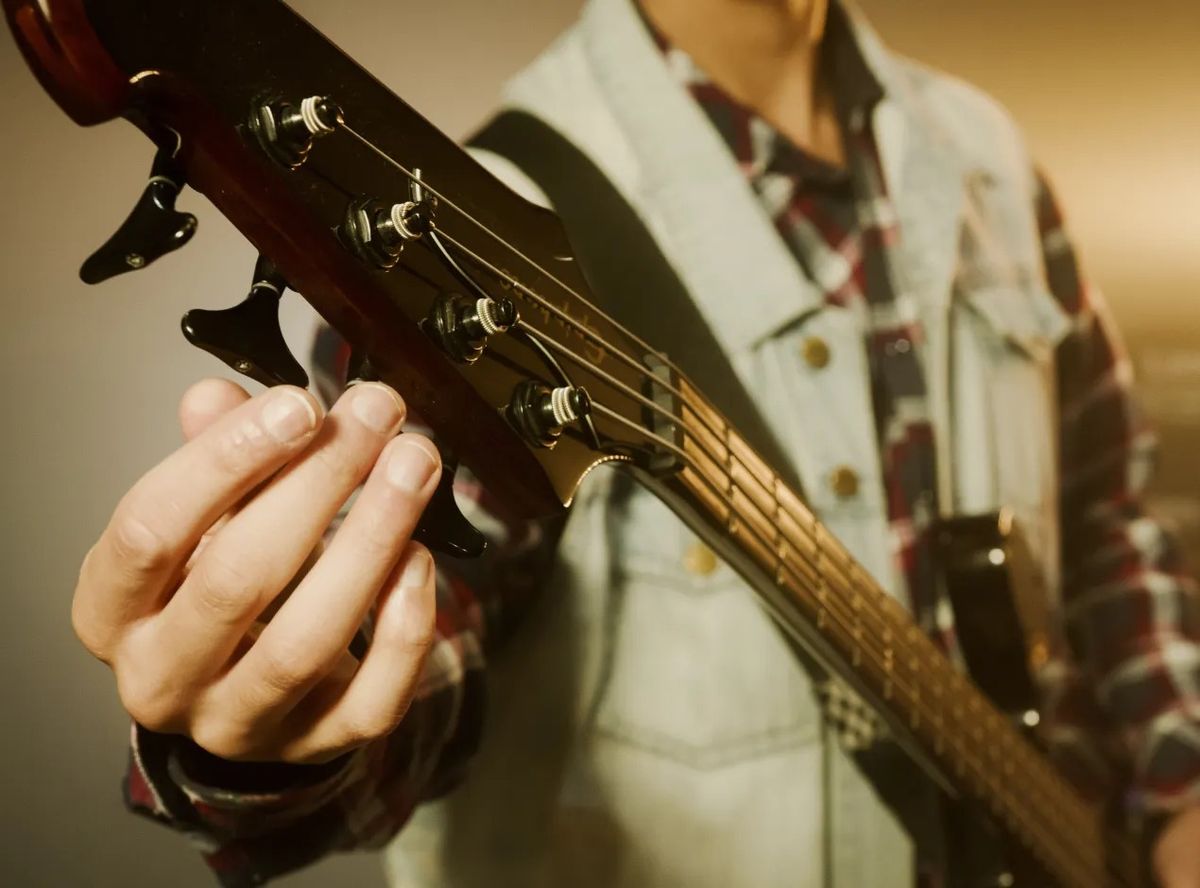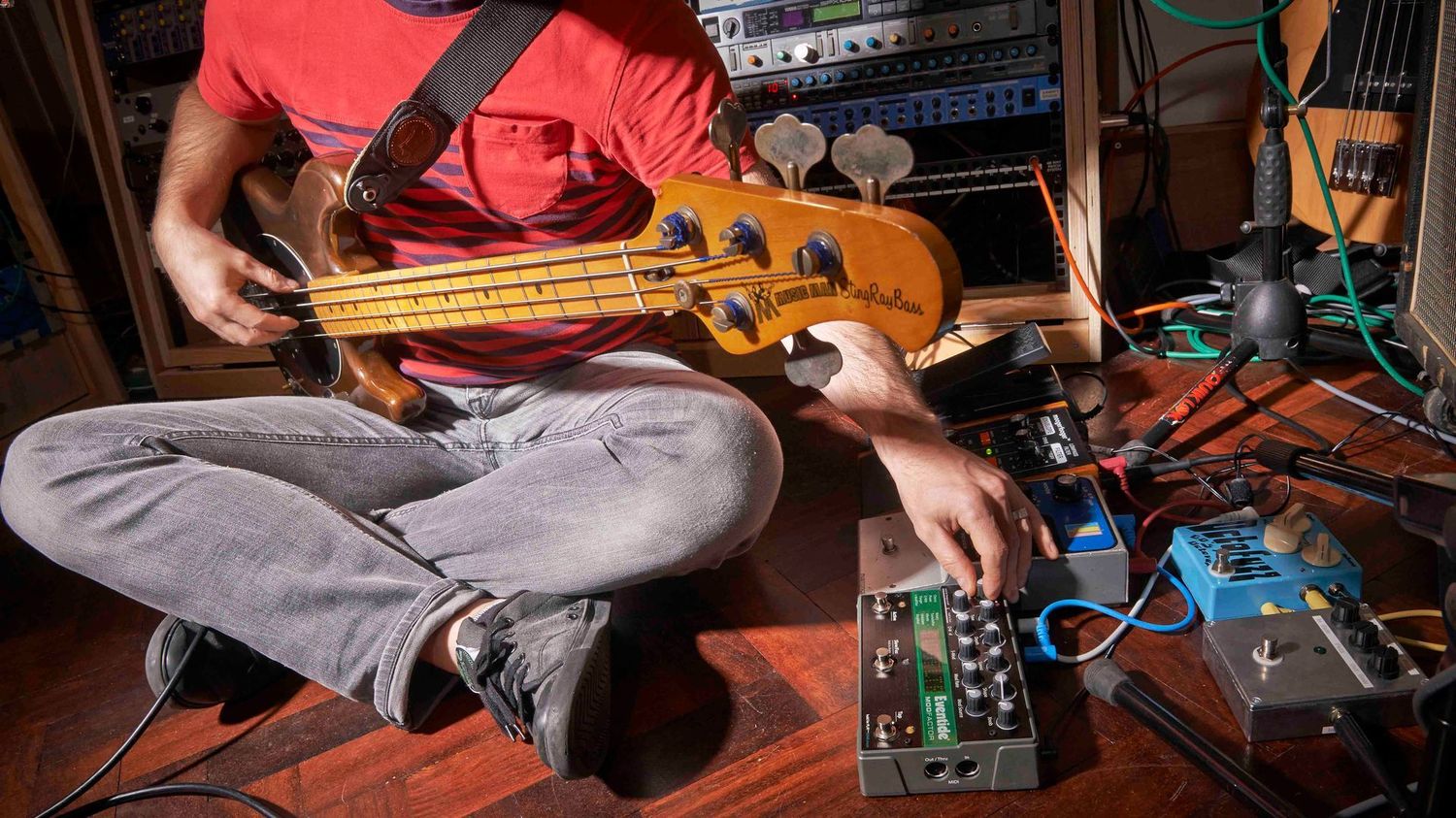Home>Instruments>Bass>How Do You Play A Bass Guitar


Bass
How Do You Play A Bass Guitar
Modified: February 14, 2024
Learn how to play a bass guitar with our step-by-step guide. Discover essential techniques and tips for mastering the bass. Improve your skills and become a skilled bass player.
(Many of the links in this article redirect to a specific reviewed product. Your purchase of these products through affiliate links helps to generate commission for AudioLover.com, at no extra cost. Learn more)
Table of Contents
Introduction
Playing the bass guitar is an art form that adds depth and richness to music. Whether you’re a beginner or an experienced musician, understanding how to play bass guitar is a journey that’s worth embarking on. The bass guitar serves as the backbone of the band, providing the rhythmic foundation and adding a melodic layer to the music.
In this article, we will explore the basics of playing bass guitar, from holding and positioning the instrument to mastering techniques and developing a unique style. By the end of this guide, you’ll have a solid foundation to build upon and the ability to create grooves that will make heads turn.
The first step in learning how to play the bass guitar is to familiarize yourself with the instrument. The bass guitar typically has four strings, although there are variants with five or six strings. It is larger than a regular guitar and has a longer scale length. The strings of the bass guitar are thicker, which produces a deep and resonant sound. Understanding the anatomy of the bass guitar, such as the neck, frets, and pickups, will help you navigate the instrument more efficiently.
Playing the bass guitar requires a different approach compared to playing other instruments. As a bassist, your primary role is to maintain the rhythm and provide a solid foundation for the rest of the band. This often involves playing single notes or root notes in a repetitive pattern, complementing the drummer’s beat. However, it’s essential to remember that the bass guitar is not just a supporting instrument; it can also take on a lead role, adding melodic and rhythmic elements to the music.
Throughout this article, we will delve into the various techniques, scales, and chords that will help you become a proficient bassist. We will also explore the importance of groove and rhythm in bass playing, as well as provide valuable tips to improve your overall bass guitar skills.
So, if you’re ready to embark on a musical journey that will make your music come alive, let’s dive into the world of bass guitar playing!
Understanding the Basics
Before diving into playing the bass guitar, it’s essential to understand some basic concepts that will form the foundation of your skills. Here are a few key elements to keep in mind:
- Notes and Frets: The bass guitar is a fretted instrument, meaning that it has metal bars or “frets” along the neck. Each fret represents a different note, allowing you to play various pitches as you press down on the strings. Familiarize yourself with the names and locations of the notes on the bass guitar.
- Tuning: Ensuring that your bass guitar is properly tuned is crucial for producing the correct notes and achieving a harmonious sound. The standard tuning for a 4-string bass guitar is E-A-D-G, from lowest to highest string. Use an electronic tuner or a tuning app to tune your bass guitar accurately.
- Rhythmic Timing: As a bassist, your role is to lock in with the drummer and provide a solid foundation for the rhythm section. Understanding rhythmic timing is crucial for maintaining a steady groove. Practice playing along with a metronome or drum tracks to improve your sense of timing.
- Finger Placement: One of the crucial aspects of bass guitar playing is proper finger placement on the fretboard. Use the tips of your fingers to press down on the strings, ensuring a clean and clear sound. Practice positioning your fingers accurately to produce accurate notes and reduce unwanted string noise.
- Pick vs. Fingerstyle: There are different techniques to play the bass guitar, primarily using either a pick (plectrum) or your fingers. Experiment with both methods and choose the one that feels most comfortable and produces the desired sound for the music you’re playing.
Mastering these basics will provide a solid foundation for your bass guitar playing. It’s crucial to spend time familiarizing yourself with these concepts before moving on to more advanced techniques. Remember, practice is key when it comes to learning any musical instrument, so be patient and consistent in your efforts.
Holding and Positioning the Bass Guitar
Holding and positioning the bass guitar properly is vital for both comfort and playability. Here are some guidelines to ensure you adopt the correct posture:
- Standing Position: If you prefer to play the bass guitar while standing, start by placing a guitar strap over your shoulder and adjusting it to a comfortable height. The bass should rest on your torso, with the neck angled slightly upward for easy access to the frets. Keep your back straight, and distribute the weight of the instrument evenly across your body.
- Sitting Position: When playing the bass guitar sitting down, choose a sturdy and comfortable chair or stool. Sit with your back straight and both feet planted firmly on the ground. Rest the bass guitar on your thigh, keeping the neck of the instrument at an angle that allows your hands to navigate the fretboard comfortably.
- Hand Positions: Your left hand will be responsible for pressing down the strings on the fretboard. Position your thumb on the back of the neck, opposite your fingers. This allows for greater reach and flexibility. Your right hand will either pluck the strings with your fingers or use a pick. Experiment with different hand positions to find what feels most natural and comfortable for you.
- Balance and Mobility: Maintaining balance and mobility while playing the bass guitar is crucial. Make sure your posture allows for free movement of both hands across the fretboard and plucking area. Avoid any unnecessary tension or strain in your muscles. Relax your shoulders and arms to achieve a comfortable and fluid playing style.
- Strap Adjustment: When using a guitar strap, adjust it to a height that allows you to reach all areas of the fretboard comfortably. Avoid having the bass guitar too low, as it can strain your wrists and impede your playing technique. Finding the ideal strap length will result in a balanced and accessible playing experience.
Remember, finding the right position that works for you may require some experimentation. As you spend more time playing, you’ll discover what feels most comfortable and allows for the best technique. Pay attention to your posture and make adjustments as necessary to avoid discomfort or injury.
Playing Techniques for Bass Guitar
Developing a diverse range of playing techniques is essential for expressing yourself on the bass guitar. Here are some key techniques to explore:
- Fingerstyle: Fingerstyle playing involves plucking the strings with your fingers, typically using your thumb for the lower strings and your index, middle, and ring fingers for the higher strings. This technique allows for greater control and dynamics, and is commonly used in various genres of music.
- Pick: Using a pick, also known as a plectrum, provides a different tone and attack. It’s great for creating a precise and consistent sound while maintaining a steady rhythm. Experiment with different pick sizes and materials to find the one that suits your playing style and desired tone.
- Slap and Pop: Slapping involves striking the strings with the thumb of your plucking hand and letting it bounce off the fretboard, creating a percussive sound. Popping, on the other hand, involves pulling or plucking the strings away from the fretboard with your fingers, creating a distinctive snapping sound. Slap and pop techniques are commonly used in funk, rock, and R&B music.
- Hammer-ons and Pull-offs: Hammer-ons involve using your fretting hand to tap the string onto a higher fret without picking it. Pull-offs, on the other hand, involve pulling a finger off a higher fret to create a note on a lower fret. These techniques can add fluidity and speed to your playing, allowing for seamless transitions between notes.
- Slides: Sliding involves transitioning from one note to another by smoothly gliding your finger along the same string. Slides can add a smooth and expressive quality to your playing, creating melodic and dynamic phrases.
- Chording: Chords on the bass guitar involve playing multiple notes simultaneously. While the bass guitar is traditionally a melodic instrument, learning chords can add depth and versatility to your playing. Experiment with different voicings and chord progressions to expand your musical vocabulary.
Remember, mastering these techniques takes time and practice. Start slowly and gradually increase your speed and precision. Work on exercises and practice routines designed specifically for each technique to build muscle memory and coordination. As you become more comfortable with these techniques, you’ll be able to incorporate them into your playing style naturally.
Mastering Scales and Chords on Bass Guitar
Understanding scales and chords is essential for creating melodic and harmonious bass lines. Here are some key concepts to help you master scales and chords on the bass guitar:
- Major and Minor Scales: The major scale is the foundation of Western music and provides a framework for creating melodies and harmonies. The minor scale, on the other hand, has a darker and more introspective sound. Learn the patterns and fingerings for both the major and minor scales, and practice playing them up and down the neck.
- Pentatonic Scales: Pentatonic scales are widely used in various musical genres and provide a versatile and melodic foundation for bass lines. They consist of five notes per octave, omitting the 4th and 7th degrees of the major scale. Explore different positions and patterns of pentatonic scales on the bass guitar to expand your improvisation skills.
- Arpeggios: Arpeggios are chords played one note at a time, creating a flowing and melodic sound. They are essential for understanding the harmonic structure of a song and can be used to create interesting bass lines and solos. Practice playing the arpeggios of various chord progressions to enhance your improvisation skills and understanding of harmony.
- Chord Voicings: As a bassist, it’s important to understand and play different chord voicings. Experiment with different inversions and positions of chords, and learn how they interact with the root notes you play. By incorporating chord tones in your bass lines, you can add depth and harmonic richness to your playing.
- Transposition: Transposing scales and chord progressions to different keys is a valuable skill for a bassist. Practice playing scales and chords in different keys to develop your transposing abilities. This will allow you to adapt to various musical situations and play with musicians in different settings.
- Ear Training: Developing your ear is crucial for recognizing and reproducing different scales and chords. Train your ear by listening to various styles of music and trying to identify the scales and chords being used. This will enhance your ability to play by ear and improvise confidently.
To master scales and chords on the bass guitar, practice diligently and focus on accuracy and precision. Start by learning the basic scales and chord shapes, and gradually work your way up to more advanced concepts. Incorporate scale and chord exercises into your practice routine to build muscle memory and develop a solid foundation of knowledge.
Remember, scales and chords are tools to express yourself as a musician and create captivating bass lines. As you gain more experience and confidence, you’ll be able to incorporate these concepts seamlessly into your playing, adding depth and complexity to your bass lines.
Developing a Groove and Rhythm on Bass Guitar
One of the most important roles of a bassist is to provide a solid groove and rhythm for the music. Developing a strong sense of timing and groove will make you an invaluable member of any band. Here are some tips to help you develop a strong groove and rhythm on the bass guitar:
- Locking in with the Drummer: The bass guitar and drums are the foundation of the rhythmic section. Pay close attention to the drummer and focus on locking in with their bass drum and snare drum patterns. By playing in sync with the drummer, you create a tight and cohesive rhythm section.
- Understanding Syncopation: Syncopation involves playing notes or rhythms that fall on the offbeat or in between the beats. Experiment with syncopated rhythms to add a dynamic and groovy feel to your bass lines. This will help propel the music forward and make it more interesting and engaging.
- Utilizing Ghost Notes: Ghost notes are softer, muted notes that add texture and depth to your bass playing. They are played by lightly pressing the strings against the frets without fully fretting a note. Incorporate ghost notes into your playing to create a subtle rhythmic pulse, giving your bass lines a more nuanced and groove-oriented feel.
- Playing with Dynamics: Dynamics refer to the variations in volume and intensity of your playing. Experiment with playing softly and loudly, and emphasize certain notes or beats to create tension and release. Playing with dynamics adds depth and emotion to your bass lines, making them more captivating and engaging.
- Experimenting with Groove Styles: Different genres of music have specific groove styles and rhythmic feels. Explore various styles such as funk, rock, reggae, jazz, and more. Pay attention to the rhythmic patterns, accents, and syncopations used in each style. This will allow you to adapt your playing and create the appropriate groove for the music you are playing.
- Listening and Analyzing: Take the time to actively listen to different genres and bass players. Analyze their rhythmic choices, phrasing, and use of space. This will expand your rhythmic vocabulary and inspire you to develop your unique groove style.
- Playing with a Metronome: Practicing with a metronome is a great way to develop your sense of timing and precision. Start by playing simple bass lines at a slow tempo and gradually increase the speed as you become more comfortable. The metronome will help you internalize the beat and stay consistent in your playing.
Remember, developing a groove and rhythm on the bass guitar is an ongoing process that requires patience and practice. Focus on being solid and consistent in your playing, and work on creating a pocket with the drummer. As you continue to refine your sense of groove and rhythm, you’ll become a sought-after bassist who elevates the overall musical experience.
Tips for Improving Your Bass Guitar Playing
Continuous growth and improvement is key to becoming a proficient bass guitarist. Here are some tips to help you enhance your skills and take your bass playing to the next level:
- Practice Consistently: Consistent practice is essential for improving your bass guitar playing. Set aside regular practice sessions to work on technique, scales, chords, and repertoire. Even short daily practice sessions can yield significant progress over time.
- Focus on Technique: Pay attention to your technique and work on proper finger placement, posture, and hand position. Building a solid foundation of technique will allow you to play more comfortably, efficiently, and with better control.
- Learn from Different Styles and Bassists: Expand your musical horizons by exploring different genres and studying the playing styles of various bassists. The more diverse your influences, the more versatile and creative you’ll become as a bass player.
- Study Music Theory: Understanding music theory can greatly enhance your bass playing. Learn about scales, chords, key signatures, and chord progressions. This knowledge will enable you to communicate with other musicians, improvise, and compose your own bass lines.
- Jam with Other Musicians: Playing with other musicians is a great way to improve your overall musicianship. Join a band or find opportunities to jam with other musicians. This will help you develop your ability to listen, interact, and adapt to different musical situations.
- Record and Listen to Yourself: Record your practice sessions or performances and listen back to them critically. This will help you identify areas for improvement, such as timing issues, weak spots in your technique, or areas where you can add more creativity and expression.
- Take Lessons from a Skilled Teacher: Working with a knowledgeable bass guitar teacher can provide valuable guidance and feedback. A teacher can help you identify areas for improvement, provide personalized instruction, and introduce you to new techniques and concepts.
- Attend Workshops and Music Camps: Participate in bass guitar workshops and music camps to learn from experienced musicians and connect with fellow bassists. These events provide opportunities for growth, inspiration, and networking in the music community.
- Stay Inspired and Motivated: Keep your passion for playing the bass guitar alive by regularly seeking inspiration. Attend concerts, listen to diverse music genres, watch videos of skilled bassists, and surround yourself with a community of like-minded musicians.
- Be Patient and Enjoy the Journey: Learning the bass guitar is a lifelong journey, and progress takes time. Be patient with yourself and celebrate small victories along the way. Enjoy the process of learning and playing music, and let your passion drive you forward.
By incorporating these tips into your practice routine, you can accelerate your growth as a bassist and develop your own unique sound and style. Remember, the key is consistent practice, a thirst for knowledge, and a genuine love for the instrument.
Conclusion
Congratulations! You’ve now gained a solid understanding of the fundamentals and techniques involved in playing the bass guitar. As you continue to explore and practice, you’ll unlock the true potential of this incredible instrument.
Remember, playing the bass guitar is not just about mastering the technical aspects or memorizing scales and chords. It’s about finding your own voice and using the instrument to convey emotion, groove, and rhythm. Pay attention to the subtleties of your playing, and strive to create a connection with the music and your fellow bandmates.
Continue to challenge yourself by learning new styles, exploring different techniques, and pushing the boundaries of your musical creativity. Embrace the opportunity to collaborate with other musicians and always remain open to learning from them.
Stay committed to consistent practice and improvement. Even dedicating a few minutes each day to practicing will make a significant difference in your progress. Remember that progress is not a linear path, and there will be moments of frustration. Embrace these challenges as opportunities for growth and breakthroughs.
Lastly, always keep the joy and passion for playing the bass guitar alive. It’s this love for the instrument that will fuel your desire to constantly improve and explore new musical horizons. Enjoy the journey, have fun with your playing, and let the bass guitar be your conduit for self-expression and musical innovation.
Now, go forth and make the bass guitar sing!











